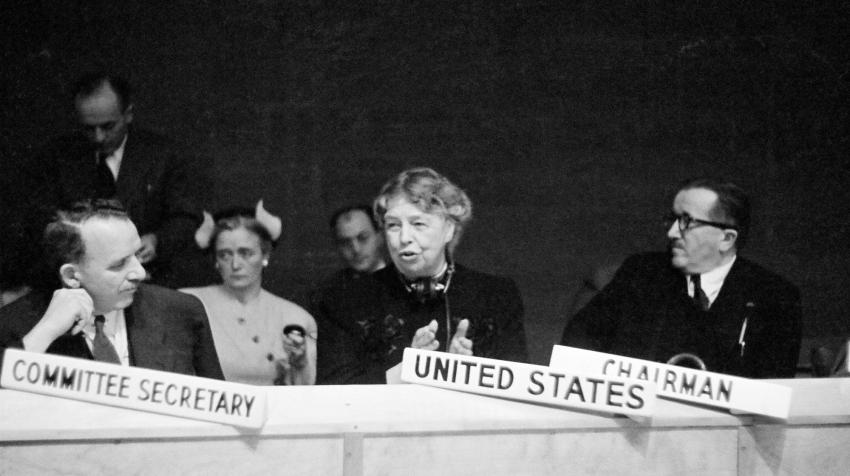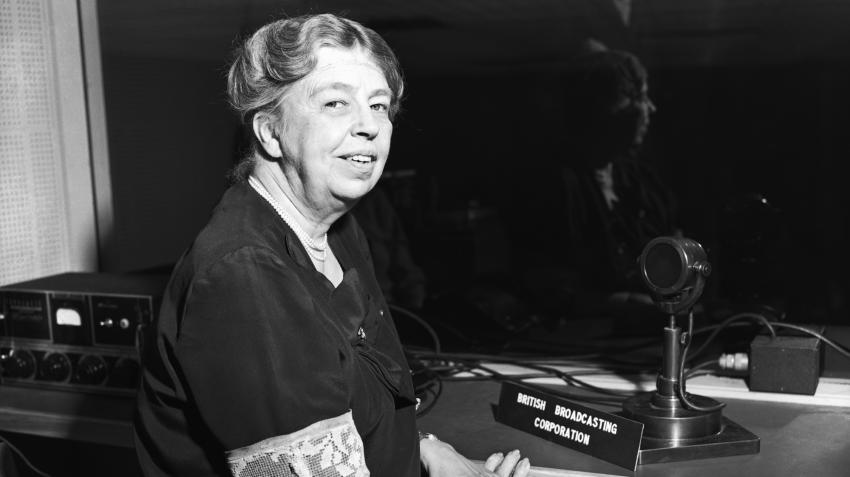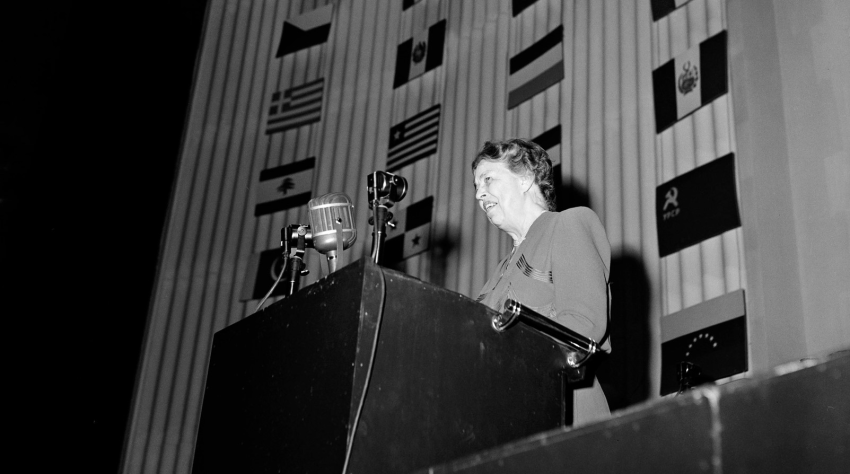8 December 2023
Eleanor Roosevelt initially declined appointment to the United Nations, telling United States President Harry Truman that while she appreciated his offer, she felt unqualified to hold the post. But by the end of that day in December 1945, she called the President to say she had changed her mind.
Earlier that year, she had rejected pleas to run for the United States Senate, become Secretary of Labour or head a major university. She wanted to speak for herself after all the years of Franklin Roosevelt’s public service and assured all who approached her that “my voice would not be silent”.
She could not sit on the sidelines as others built the United Nations. She had witnessed the trauma that war and extreme deprivation inflicted upon the world. She had long championed international organizations dedicated to peace—the League of Nations, the World Court, the International Committee for the Cause and Cure of War—and shared Franklin Roosevelt’s vision for the United Nations, but her visits to hospitals and battlefields of the Second World War continued to haunt her. “Dear Lord,” she prayed, “Lest I continue my complacent way, help me to remember that somewhere, somehow out there, a man died for me today. As long as there be war, I then must ask and answer, am I worth dying for?”
Her male delegation colleagues, distressed at her appointment, thought that if she served on the United Nations Committee for Social, Humanitarian and Cultural Concerns, she would work on issues they considered inconsequential as they focused on structuring the Security Council and regulating atomic weapons. No one anticipated how her stature would increase as she argued against the forced repatriation of 60 million displaced people. Nor did she foresee how United Nations debates on the Geneva Conventions, atomic energy, arms control, the proposed United Nations peace force, the creation of Israel, the implementation of apartheid, the demise of colonialism, and women’s rights would compel her to act. No one predicted she would be unanimously elected to chair the United Nations Commission on Human Rights. As she wrote to a dear friend, “against the odds, the women inch forward, but I am rather too old to be carrying on the fight!”1
The world had never agreed on a common concept of rights, and now it had to do so in the shadow of unimaginable horror and economic uncertainty.
The battle to create an international vision of human rights drew on every skill Eleanor Roosevelt possessed—and challenged her in ways she never envisioned. Worried that escalating cold war political tensions could easily spark another world war, she decided to push for a comprehensive agreement that could be adopted as quickly as possible. Convinced that a fearful world, still recovering from the worst war in its history, needed a vision sooner than it needed a treaty, she urged that the Human Rights Commission’s assignment be separated into three complementary tasks: drafting a declaration of human rights and a covenant to enforce them, and the creation of a human rights court to hold violators accountable. Convinced that Harry Truman would not be elected, and that she would not be reappointed to the United Nations, she strove to have a declaration adopted by the end of 1948.
Drafting the Universal Declaration of Human Rights required monumental effort. The world had never agreed on a common concept of rights, and now it had to do so in the shadow of unimaginable horror and economic uncertainty. As commission chair, Eleanor Roosevelt endeavoured to create a climate in which all 18 member nations—presenting governments that had no common conception of citizenship, government, politics, property, religion or identity—could envision, debate and articulate rights.

Ultimately, she would chair more than 3,000 hours of contentious deliberation to define human rights and decide whether or not they applied to all men, women and children everywhere, regardless of race, religion, ethnicity, nationality, age, country of origin, income and social status. What was the philosophical basis for human rights? How were women’s human rights recognized and protected? What did the right to work, the right to wages and income, the right to assemble, the right to food and shelter, the right to education, the right to dissent, the right to vote and participate in government, the right to nationality, and the guarantees against torture and discrimination mean? How would the guarantee of equal treatment in one’s community or government or workplace work in different political systems? What made a human rights violation so egregious that the offending nation’s sovereignty could be challenged? Moreover, as chair of the drafting committee, she also had to make sure that the vision she guided the commission to create was presented in clear, readily comprehensible and empowering prose.
As the Universal Declaration of Human Rights took shape, Eleanor Roosevelt had to convince a reluctant, if not outright resistant, United States State Department to accept a definition of human rights that included social, economic and cultural rights rather than just civil and political rights. Then she had to convince the Soviets not to object to the provisions of the Declaration dealing with civil and political rights. Finally, she had to convince the General Assembly to adopt the Declaration. No one other than Eleanor Roosevelt could have navigated this minefield.
In many ways, we face the same choice Eleanor Roosevelt faced—whether to cede dreams to fear and rights to politics.
Eleanor Roosevelt dedicated her life to promoting the Universal Declaration of Human Rights, defending the United Nations and urging women’s involvement in international affairs. In her parting words to the Organization, she urged the adoption of the Convention on the Political Rights of Women. Once she left the United Nations in late December 1952, she travelled the world challenging lawyers and legal associations, elected officials and Heads of State, and universities and non-governmental organizations to adhere to its principles. She flew to Tokyo to assist Japanese women demanding that their rights be respected in the nation’s new constitution and met with the survivors of the Hiroshima and Nagasaki bombings. When visiting India, she developed a close alliance with Jawaharlal Nehru and those who risked their lives for independence, and became a staunch ally of Vijaya Lakshmi Pandit. At home, she led workshops on human rights and non-violent civil disobedience for civil rights activists and labour organizers, and raised funds to support their actions. She turned her Val-Kill cottage in the State of New York into a classroom for students and African delegates seeking a safe place to collaborate, and used her nationally syndicated column to educate readers on why human rights were essential to life, peace and hope. She spent her final days pressing United States President John F. Kennedy to appoint more women to senior positions in government and chairing the first United States Presidential Commission on the Status of Women.
Her actions did not please all human rights activists. She believed women’s rights could not be separated from universal human rights and worried that consultative bodies such as the Commission on the Status of Women could inadvertently marginalize women’s rights. She urged women within the United Nations to use their power to bring more women into the body and promote and protect women’s rights, hoping that an alliance of women within the United Nations and its member governments, working in tandem with women’s organizations, would build a forceful coalition. A few major feminist organizations loudly criticized her stance.

Her actions also provoked fierce responses from other critics. The Ku Klux Klan placed a bounty on her head, assassination attempts increased, attacks on her character intensified, politicians impugned her character and publishers cancelled some of her contracts. Yet Nelson Mandela, Rosa Parks and others who faced similar threats read her works and praised her commitment.
Eleanor Roosevelt died before the United Nations adopted conventions addressing women’s rights and before millions of women around the globe organized to press governments and the human rights community to embrace women’s rights as human rights. Yet her influence at the 1993 Vienna World Conference on Human Rights is undeniable. There, women delegates embraced her call to action and forced the Conference to declare, “The human rights of women and of the girl-child are an inalienable, integral, and indivisible part of universal human rights”. Her firm conviction that human rights must have meaning in “small places, close to home”2 permeated the Cairo Conference on International Development and Population the following year.
One can only imagine how the Beijing Declaration and Platform for Action and the creation of UN-Women—the United Nations Entity for Gender Equality and the Empowerment of Women—would have pleased her. At the 1995 Fourth United Nations Conference on Women in Beijing, women represented their governments as well as non-governmental organizations; they negotiated unanimous adoptions of a platform they wrote that mandated government signatories to implement its planks; and they left emboldened to risk themselves in “small places, close to home” by Hillary Rodham Clinton’s pronouncement that “women’s rights are human rights and human rights are women’s rights, once and for all”. Fifteen years later, the creation of UN-Women concretized Eleanor Roosevelt’s vision: a senior body within the United Nations empowered to be “the global champion for gender equality and the empowerment of women”, designed to accelerate progress worldwide, and led by former Chilean President and human rights activist Michelle Bachelet. To underscore its importance, the Executive Director of UN-Women would also serve as an Under-Secretary-General of the United Nations.
Now, as the Universal Declaration of Human Rights reaches its seventy-fifth anniversary, the world is once again embroiled in multiple wars and intense debates over the Declaration’s scope and effectiveness. In many ways, we face the same choice Eleanor Roosevelt faced—whether to cede dreams to fear and rights to politics. However, we now have the institutions, the precedents, the tools and the legacy essential for action. We must build upon those victories and never lose sight of the vision that the Declaration and Eleanor Roosevelt left to us.
Notes
1 Eleanor Roosevelt to Joseph Lash, 13 February 1946, Joseph P. Lash Papers, Franklin D. Roosevelt Library.
2 Eleanor Roosevelt, “The Great Question”, remarks delivered at United Nations Headquarters, New York on 27 March 1958.
The UN Chronicle is not an official record. It is privileged to host senior United Nations officials as well as distinguished contributors from outside the United Nations system whose views are not necessarily those of the United Nations. Similarly, the boundaries and names shown, and the designations used, in maps or articles do not necessarily imply endorsement or acceptance by the United Nations.




